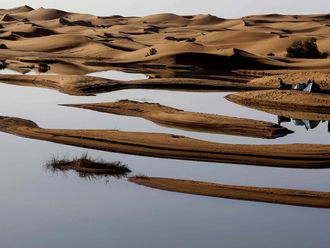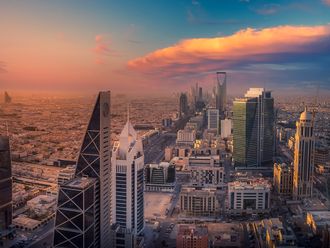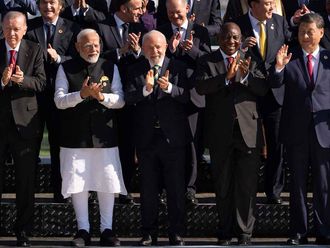Johannesburg: South Africa’s worst mine violence since the end of apartheid in 1994 has highlighted one of the world’s biggest wealth gaps that senior government officials say is stirring up social tension in Africa’s biggest economy.
Deputy President Kgalema Motlanthe and Finance Minister Pravin Gordhan warned last week that income inequality threatens the nation’s democracy, reflecting concern expressed by investors and credit rating agencies. Police shot and killed 34 striking mineworkers at Lonmin Plc’s Marikana operation last month during a protest over higher wages.
While more black South Africans have been given access to water, electricity and social welfare grants since the African National Congress swept into power 18 years ago to end whites- only rule, 60 per cent, or about 23 million, still live in poverty and 28 per cent are jobless, according to government data. The gap between rich and poor in South Africa is worse than Honduras and the Central African Republic, according to the World Bank.
“The dividends of development weren’t spread across the population as a whole,” Dirk Kotze, a politics professor at the University of South Africa, said in a phone interview from Pretoria, the capital, yesterday. “There is a high explosive potential. It is just not a labour dispute any more, it is much more emotional. The sense of polarisation is stronger than in the past.”
White South Africans, who make up nine per cent of the population, earn on average eight times more than blacks. About 80 per cent of the nation’s 49 million people are black.
Mineral Wealth
Discontent over wages sparked six days of violence last month at Lonmin Plc’s platinum mine in Marikana, in North West province, in which 10 people, including two police officers, were killed. On August 16, police opened fire as they tried to disperse a crowd of 3,000 workers staging an illegal strike. The police said they acted in self-defence after being shot at by the strikers, many of who were armed, including with fighting sticks and machetes.
Citigroup Inc estimated in 2010 that South Africa had the world’s richest mineral deposits worth $3.5 trillion (Dh12.85 trillion). Even so, the distribution of wealth in the economy is “unfair” and an “ingredient for revolution”, Motlanthe, who is also deputy president of the ANC, told reporters in Cape Town on August 29.
Gordhan echoed those comments the next day in a speech at a leadership conference in Johannesburg, warning of “serious faultlines” if citizens are excluded from the economy and political institutions.
Credit Ratings
The Gini coefficient, a measure of income inequality, was 0.63 in South Africa in 2009, the highest of 25 developing nations surveyed by the World Bank. The index was 0.59 in 1993, according to the Washington-based lender. A reading of zero means society is totally equal, while a reading of 1 means the society is completely unequal.
“Black income really hasn’t changed,” Peter Attard Montalto, an economist at Nomura Plc in London, said in a telephone interview. “That shows that the amount of progress made by the ANC is clearly limited.”
Violent protests at mines may be spreading. Police used teargas to remove about 60 former employees from the entrance to Gold One International Ltd’s Modder East mine yesterday. The protesters, who had been fired for taking part in an illegal strike, threw stones at vehicles and refused to leave the area.
Moody’s Investors Service and Fitch Ratings have cited South Africa’s unemployment and poverty as limits to economic growth and the nation’s credit rating. Moody’s, Fitch and Standard & Poor’s have a negative outlook on South African government debt.
Township Protests
“High unemployment is already associated with widespread crime, which is regularly cited as one factor deterring foreign investment,” Fitch’s sovereign analyst, Carmen Altenkirch, said in a statement on August 24. “Over time it could also threaten social and political stability, damaging the investment climate further.”
Poor, mainly black, township residents staged 113 protests against a lack of housing, sanitation and other services in the first seven months of this year, more than in any other year since monitoring began in 2004, according to Municipal IQ, an independent local government research group.
The violence at Marikana shows that social instability may be “much more of a ‘present’ risk than many had previously thought — that it is already serious enough to impact on economic outcomes today,” Razia Khan, an economist at Standard Chartered Plc in London, said in an e-mailed response to questions.
Jobless Rate
Living standards for most poor South Africans have improved since 1994: More than 95 per cent have access to clean water, up from about 62 per cent; more than three-quarters of households are electrified, from 51 per cent; and the number of people receiving welfare grants has risen more than five-fold to over 15 million.
Still, economic progress hasn’t been fast enough to make a dent in the unemployment rate, which hasn’t dropped below 22 per cent since 2000, according to government data. President Jacob Zuma, who was swept to power in 2009 with the backing of labour unions, has pledged to cut the jobless rate to 14 per cent by 2020. That requires economic growth of 7 per cent compared with average expansion of 3.5 per cent a year until 2014, according to government forecasts.
“The problem of unemployment lies with jobless young, black males,” Piet Croucamp, a politics lecturer at the University of Johannesburg, said in a telephone interview on August 29. “This is where the political tension lies.”












